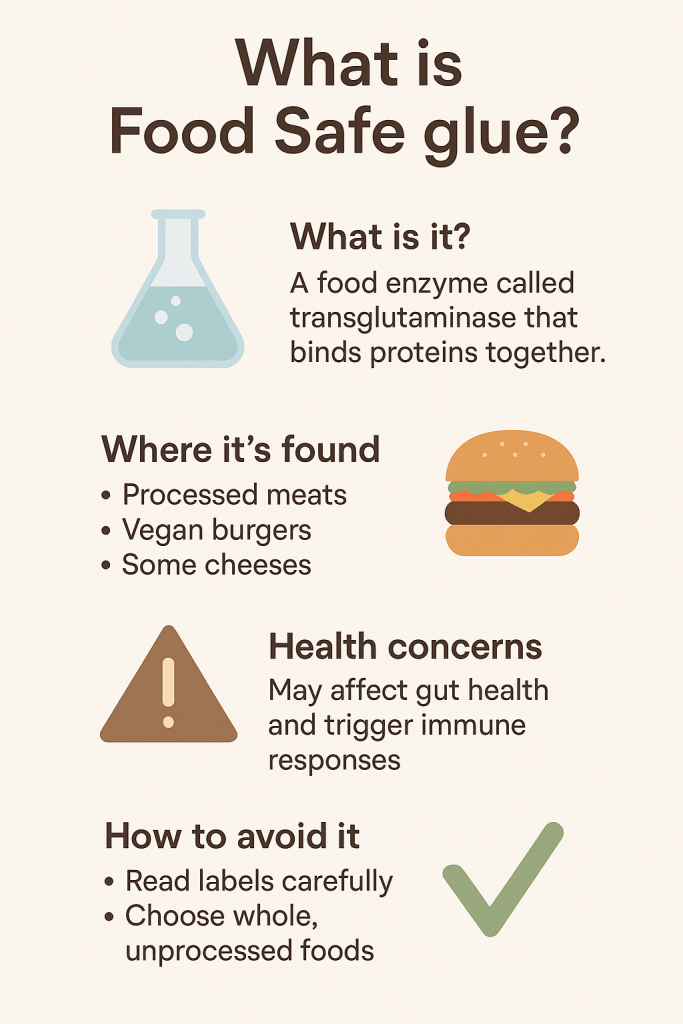Food Safe Glue – What Is Transglutaminase and What Are the Health Dangers to Humans?
Have you ever looked at a perfectly shaped ham slice or a firm plant-based burger and thought, “That can’t be natural?” You’re probably right. The secret behind many of these picture-perfect foods is something called food safe glue, better known as transglutaminase. This enzyme binds proteins together, transforming food scraps into solid portions and giving vegan products their meaty bite.
It sounds clever. However, not everyone’s convinced it’s as harmless as it seems. With more people asking, “What’s in my food?”, it’s time we looked at this invisible ingredient hiding in plain sight.
The Rise of Food Safe Glue in Everyday Foods
Transglutaminase has become a staple in food manufacturing. It allows producers to combine various meat trimmings, shape them into cohesive cuts, and market them as premium products. For instance, many supermarket deli meats, nuggets, and imitation seafood products contain it.
Even so, most labels don’t clearly state that food safe glue has been used. Instead, it’s tucked away under terms like “TG enzyme” or “processing aid.” As a result, shoppers often remain unaware.
Moreover, transglutaminase isn’t just for meat. Many dairy and plant-based items use it to improve texture and appearance. In fact, if you’ve eaten a plant-based burger recently, there’s a good chance this enzyme helped hold it together.
What Transglutaminase Really Is and How It Works
Transglutaminase occurs naturally in animals, plants, and even bacteria. The food industry typically produces it through bacterial fermentation, then processes it into a tasteless, odourless powder.
Once added to protein-rich foods, it acts quickly. It bonds proteins by linking glutamine and lysine, creating a durable structure. As a result, separate scraps of meat or plant proteins form a single, solid piece.
Chefs also use it in fine dining. They rely on it for structural finesse in elegant meat roulades or sushi. Manufacturers, on the other hand, use it to stretch profits by reducing food waste. Either way, it holds more than just food together—it holds influence over our entire eating experience.
How Food Safe Glue Transforms the Industry
This enzyme plays a major role in modern food production. Manufacturers use it to shape uniform fish portions, glue together small cuts of meat, and improve the elasticity of cheese. Additionally, it enhances gluten-free baked goods and gives dairy-free cheese a meltier texture.
In plant-based foods, transglutaminase is even more essential. Without it, soy-based burgers, vegan sausages, and other meat alternatives would likely crumble. Therefore, the enzyme has quietly become a key player in the booming alternative protein market.
Although it boosts efficiency and reduces food waste, many argue that such manipulation removes transparency from the plate. Knowing whether you’re eating real cuts or glued-together pieces should be a basic right, not a guessing game.
Is It Actually Safe to Eat? Here’s What Experts Think
The FDA and EFSA have given transglutaminase the green light—provided it’s used correctly. Regulators currently classify it as safe for human consumption. However, critics point out that most of the research only covers short-term effects.
In contrast, we know little about the long-term impact of regularly eating foods processed with this enzyme. While studies haven’t directly linked it to diseases, its presence in ultra-processed foods raises eyebrows. Not to mention, consumers often have no idea they’re consuming it.
Experts generally advise moderation. They recommend avoiding excessive amounts of processed food, not just because of this enzyme, but because of everything else that usually comes with it—sodium, additives, preservatives, and unhealthy fats.
What Are the Potential Health Risks of Food Safe Glue?
While transglutaminase may sound safe, some studies suggest it could interfere with gut function. One concern is its potential to increase intestinal permeability—commonly called leaky gut. This condition allows toxins and partially digested food to pass into the bloodstream, which may trigger inflammation and autoimmune responses.
Furthermore, because transglutaminase alters protein structures, your immune system might mistake these new proteins for threats. In those with food sensitivities or autoimmune conditions like coeliac disease, this reaction could aggravate symptoms or cause flare-ups.
Although more research is needed, many experts agree that people with compromised gut health or autoimmune issues should avoid foods containing food safe glue whenever possible.
Can It Cause Inflammation or Autoimmune Reactions?
Yes, it’s possible—especially for those already prone to immune responses. For example, people with inflammatory bowel disease, lupus, or rheumatoid arthritis may react more strongly to the new protein structures created by transglutaminase.
The enzyme closely resembles tissue transglutaminase, the human enzyme involved in coeliac disease. Consequently, the body may launch a defensive attack, mistaking it for a natural threat. As this immune activity increases, so does inflammation.
Therefore, experts recommend that anyone with a sensitive immune system or ongoing inflammation limit their exposure to transglutaminase.
Could Food Safe Glue Increase Cancer Risk?
No evidence directly links transglutaminase to cancer. However, most of the foods that contain it are classified as ultra-processed. These include deli meats, imitation seafood, frozen entrees, and some plant-based fast foods.
Ultra-processed foods have been associated with higher risks of cancer, particularly colorectal cancer. While the enzyme may not be carcinogenic on its own, it’s often part of a bigger nutritional problem. If you’re eating lots of restructured products, you’re likely also consuming other ingredients linked to long-term health concerns.
Limiting these foods could reduce your overall risk—not just because of the glue, but because of everything else that tends to come with it.
How to Identify It on Food Labels
Spotting food safe glue requires careful label reading. It’s rarely listed outright. Look instead for:
-
“Transglutaminase”
-
“TG enzyme”
-
“Enzyme preparation”
-
“Processing aid”
Also, keep an eye out for phrases like “restructured meat” or “formed product.” These often signal that the food has been shaped or held together using this enzyme. In restaurants, unless you ask, you’ll probably never know it’s there.
Natural Alternatives You Can Use at Home
You don’t need food safe glue to make great meals. Several safe, natural binders work just as well:
-
Egg whites provide excellent binding for patties and meatballs.
-
Chia seeds or flaxseeds, when soaked, create a gel that holds ingredients together.
-
Potato or rice starch adds cohesion and is especially good in gluten-free recipes.
-
Gelatin works well in cold dishes and meat-based terrines.
These options offer similar results without synthetic additives or potential immune responses.
Should You Be Concerned?
If you’re healthy and eat a varied diet, occasional exposure to food safe glue likely won’t hurt. However, if you have allergies, coeliac disease, autoimmune disorders, or a sensitive gut, you might want to steer clear. At the very least, it’s worth knowing when and where you’re consuming it.
Informed choices are the best kind. By learning how to spot these ingredients, you gain control over what you eat and how you feel. And that’s what real health empowerment looks like.
Tips to Avoid Food Safe Glue
-
Buy whole cuts of meat rather than restructured or formed products.
-
Cook more meals from scratch to reduce reliance on processed foods.
-
Read ingredient labels thoroughly.
-
Choose brands that are transparent about their methods.
-
Ask restaurants how their foods are prepared.
These small steps add up to big changes in how you eat—and how you feel.
Conclusion: Take Control of Your Plate
Food safe glue may make life easier for food manufacturers, but it creates real concerns for consumers. It’s often hidden, not well-labelled, and rarely explained. While regulators consider it safe, science still has unanswered questions—especially when it comes to the immune system and gut health.
The solution? Stay informed, read labels, and ask questions. The more you know, the better choices you can make. You deserve food that fuels your body—not one that sneaks in surprises.
Next time you’re shopping or dining out, don’t be afraid to ask: “Is this food glued together?”
FAQs
1. What is food safe glue?
It refers to transglutaminase, an enzyme that binds proteins together in processed foods.
2. Is it dangerous to eat?
Not always, but it may aggravate conditions like coeliac disease, IBS, or autoimmune disorders.
3. Where is food safe glue commonly used?
It’s found in restructured meats, processed seafood, dairy alternatives, and some vegan products.
4. How can I avoid it?
Look for terms like “TG enzyme” or “enzyme preparation” on labels. Choose whole foods whenever possible.
5. What can I use instead of it?
Natural alternatives include egg whites, chia seeds, flaxseed gel, and potato starch.
Well there you have it. We thought that people should be made aware of the potential hazards of this commonly used stuff. If you found this article useful and would like to read more similar posts on what is in our food, and the truth about how big pharmaceutical companies have not been up front about their medications.






